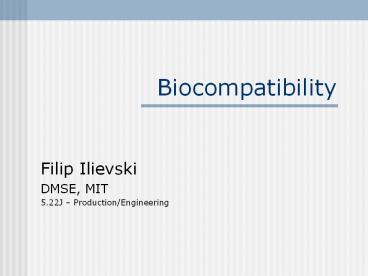Biocompatibility PowerPoint PPT Presentation
1 / 30
Title: Biocompatibility
1
Biocompatibility
- Filip Ilievski
- DMSE, MIT
- 5.22J Production/Engineering
2
Overview
- Biomaterials and rules of selection
- Basic materials science
- Surface properties influencing host response
- Modes of failure of biomaterials
- Look at stainless steel and cobalt chromium
alloys - Conclusions
- Questions
3
What are Biomaterials?
- A nonviable material used in a medical device,
intended to interact with biological systems.
Williams, 1987
4
What governs materials choice?
- Historically
- Bulk properties matched to those of natural
organs - Mechanical (ex. modulus)
- Chemical (ex. degradation)
- Optical (ex. whiteness)
- Ability to process
- Federal Regulations
5
What governs materials choice? (cont.)
- Today
- Rational design of biomaterials based on better
understanding of natural materials and their
material/biological organism interface - Adoption of the Materials Engineering Paradigm
6
Materials Engineering Paradigm
7
What is Structure?
- Primary Chemical Structure
- Primary Bonds
- Secondary Bonds
- Higher Order Structure (1-100nm)
- 3D arrays of atoms or molecules
- Microstructure (1um)
- Crystal Grains
8
Higher Order Structure
BCC
FCC
webelements.com
9
Microstructure
Lehigh U Institute for Metal Forming
10
Surface Properties
- Wettability
- Roughness
- Electrical Charge
- Crystallinity
- Composition
- Mobility
11
Surface Energy
- Surface tension, g, is the work required to
create unit surface area at constant T, P and
composition. - Minimize Gibbs free energy
- g(metals) gt g (oxides) gt g (water) gt
g(organics)
12
Surface Phenomena
- Adsorption of a species from environment
- Surface segregation of a species from bulk
- Surface reconstruction
- Surface reaction
13
Oxidation of Metals
xM ½y O2 ? MxOy
Metal Oxide
O2
O2
O2
Metal alloy
14
Acid/Base Reactions on Oxides
M2 acts as an electron pair acceptor for oxygen
lone pairs
H2O cleavage with H transfer to surface basic
O-2 site OH- coordination with M2
O2- M2 O2- M2
15
Aqueous Corrosion of Metals
- Why does it happen?
- Mz diffusion will ALWAYS occur
- Oxide may dissolve
- What is it?
- Corrosion is the destructive result of chemical
reaction between a metal or metal alloy and its
environment, and involves an electronic charge
transfer (i.e. and electrochemical reaction)
Ratner et. al.
16
Corrosion reactions
- Typically, metal surface acts both as anode and
cathode in different regions. - Anodic reaction
- M ? Mz ze-
- Cathodic reactions
- O2(dissolved) 4H 4e- ? 2H2O
- 2H 2e- ?H2?
- O2(dissolved) 4H2O 4e- ? 4OH-
acidic
basic
17
In vivo environment
- pH 7.4
- T 37oC
- Anions Cl-, PO3-, HCO3-
- Cations Na, K, Ca2, Mg2
18
Pitting corrosion of SS
Fe2 ? Fe3 e- O2 4H2O 4e- ? 4OH-
Fe ? Fe22e- Fe22Cl-2H2O ? Fe(OH)2 2HCl
Fe3 OH- ? Fe(OH)3
(Fe, Cr)2O3
Fe-9Cr
19
Other types of corrosion
- Crevice corrosion
- Fretting corrosion (mechanical damage)
- Intergranular corrosion (2 phases)
- Microbiological corrosion
- Stress corrosion cracking
Ratner, et. al.
20
Stainless steel - composition
- 316L (bar, wire, sheet, strip..)
- Fe 60-65
- Cr 17-19
- Ni 12-14
- 2-3 of
- Mn max 2
- Cu max 0.5
- C max 0.03
- N max 0.1
- P max 0.025
- Si max 0.75
- S max 0.01
Ratner, et. al.
21
SS microstructure
- Cr is added to permit development of passivating
strongly adherent Cr2O3 - Cr stabilizes the BCC, weaker than FCC
- Ni added for austenitic phase stabilization
- Low carbon because Cr23C6 can precipitate at
grain boundaries, depleting Cr from neighbouring
grains.
Ratner, et. al.
22
Microstructure affects corrosion
Lehigh U Institute for Metal Forming
23
SS mechanical properties
- Annealed
- Youngs modulus 190 GPa
- Yield strength 331 MPa
- Tensile strength 586 MPa
- Fatigue 241-276 x 107 cycles
- 30 Cold worked
- Youngs modulus 190 GPa
- Yield strength 792 MPa
- Tensile strength 930 MPa
- Fatigue 310-448 x 107 cycles
Ratner, et. al.
24
Co-Cr alloys and composition
- F75 (Co-Cr-Mo), F799 (Forged Co-Cr-Mo)
- Co 58.9-69.5
- Cr 27-30
- Mo 5-7
- lt1 Mn, Si, Ni, Fe, C
- F90 (Co-Cr-W-Ni, Wrought Co-Cr)
- Co 45-56
- Cr 19-21
- W 14-16
- Mo 9-11
- Fe max 3
- lt1 of Mn, C, P, Si, S
Ratner, et. al.
25
Co-Cr alloys continued
- F562 (Co-Ni-Cr-Mo-Ti, Biophase)
- Co 29-38.8
- Ni 33-37
- Cr 19-21
- Mo 9-10.5
- lt1 Ti, Si, S, Fe, Mn
Ratner, et. al.
26
Co-Cr microstructure
- Strongly influenced by processing
- Investment casting
- Powder isotactic pressing
- Cold and hot forging
- Annealing
Ratner, et. al.
27
Co-Cr mechanical properties
- F75 as cast or annealed/F90 annealed
- Youngs modulus 210 GPa
- Yield strength 445-517 MPa
- Tensile strength 655-889 MPa/ 951-1220MPa
- Fatigue 207-310 x 107 cycles /NA
- F562 cold forged
- Youngs modulus 232 GPa
- Yield strength 1500 MPa
- Tensile strength 1795 MPa
- Fatigue 689-793 x 107 cycles
Ratner, et. al.
28
Conclusions
- Processing ? Structure ? Properties ? Application
- Effects of structure and surfaces on properties
of materials - A wide selection of materials available
- Future work biocompatibility of each of these
alloys
29
References
- B. Ratner,A. Hoffman, F. Schoen and J. Lemons
An Introduction to Materials in Medicine,
Academic Press 1996 - C. Clerc, M. Jedwab, D. Mayer, P. Thompson, J.
Stinson, Assessment of Wrought ASTM F1058 Cobalt
Alloy Properties for Permanent Surgical Implants,
Wiley Interscience 1997 - I. De Scheerder, J. Sohier, E. Verbeken,L. Froyen
and J. Van Humbeeck, Mat.-wiss. u. Werkstofftech.
32, 142-148 (2001) - David R. Haynes, Tania N. Crotti, Michael R.
Haywood, CCC 0021-9304/00/020167-09 Wiley
Interscience (2000) - Hallie E. Placko, Stanley A. Brown, Joe H. Payer,
CCC 0021-9304/98/020292-08 Wiley Interscience
(1998)
30
Questions

